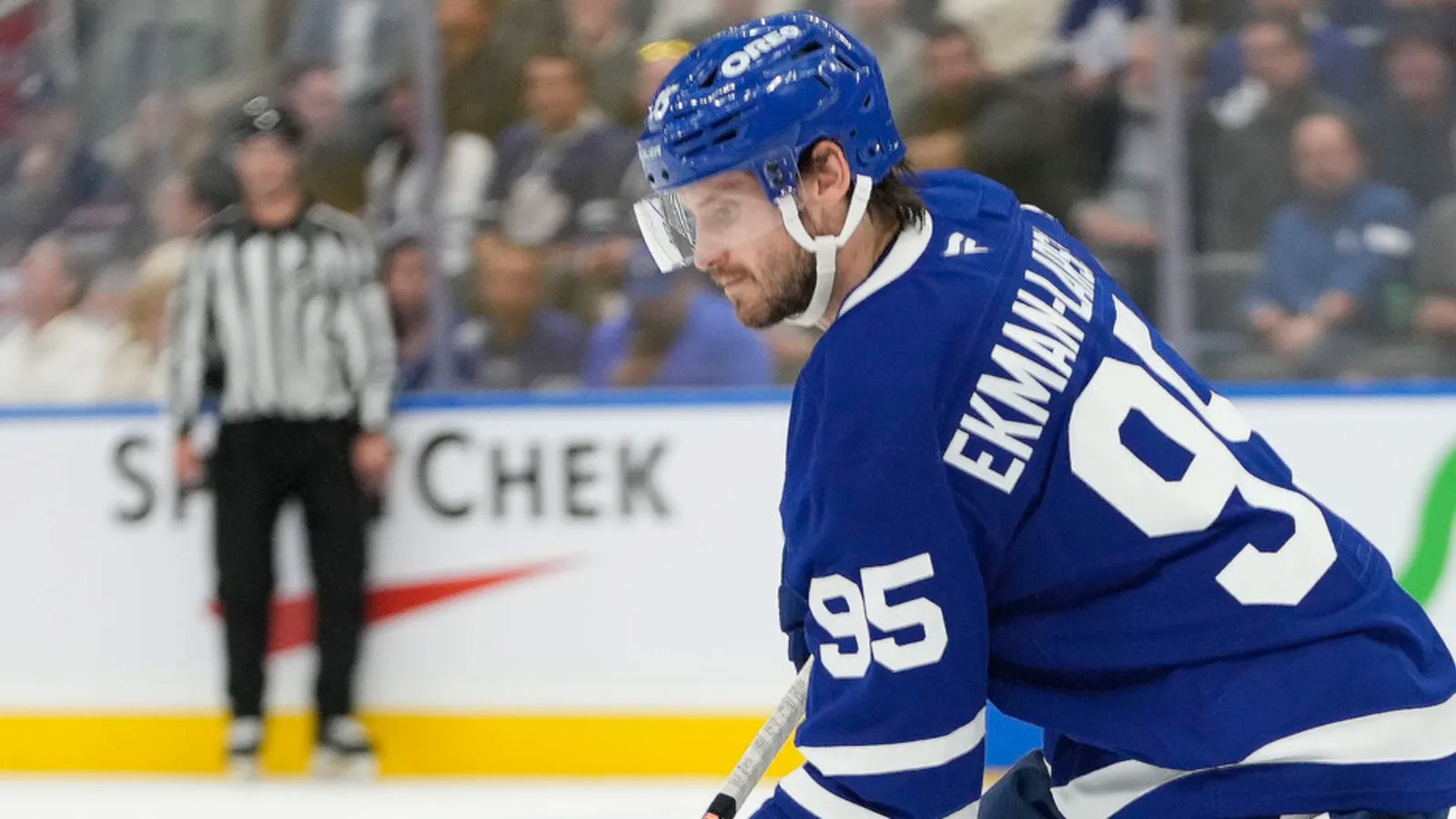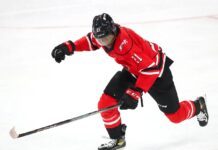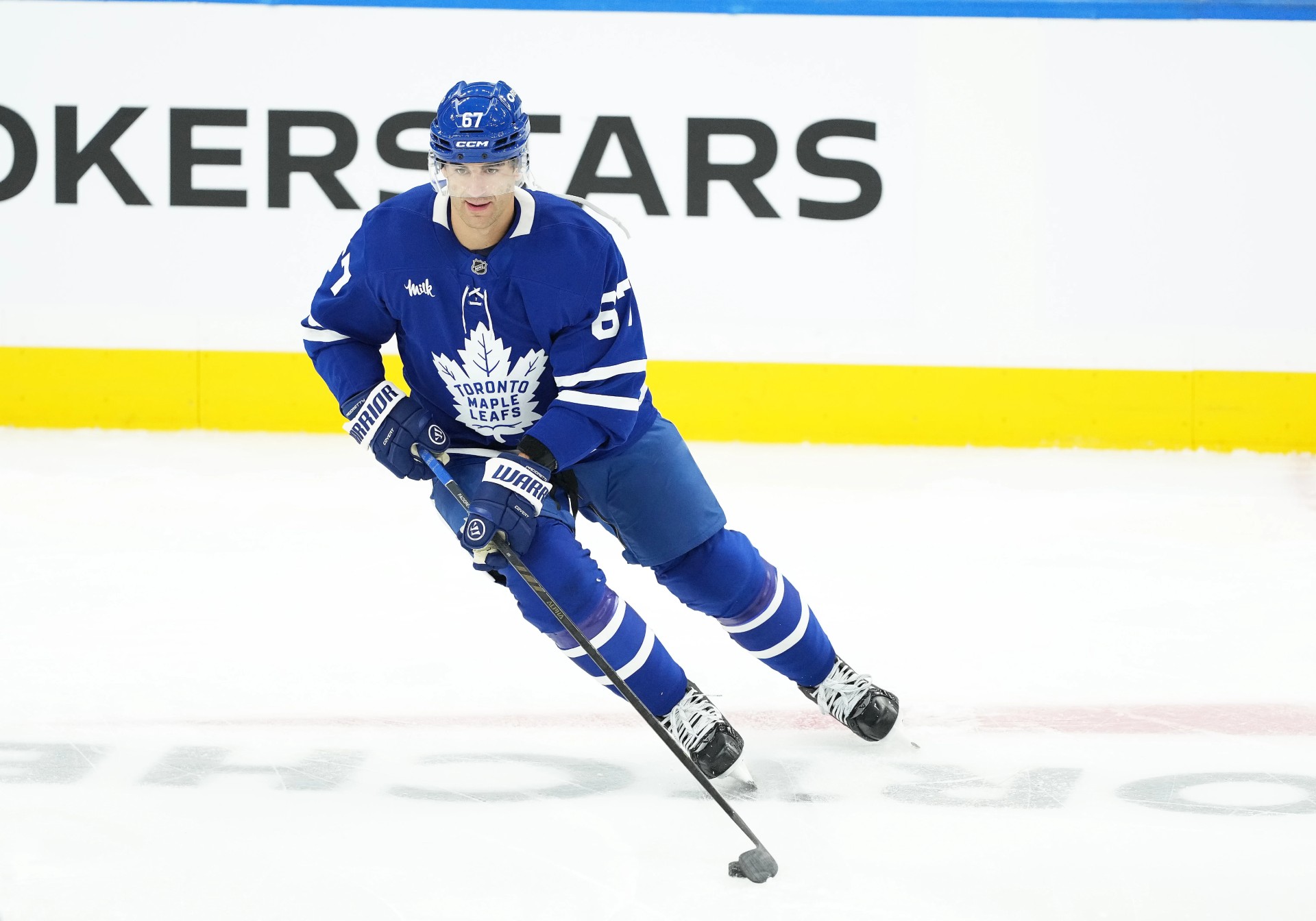With the Maple Leafs sitting at 7-5-2 through 14 games, we examined the positives and areas for improvement earlier today.
Now, it’s time to examine the individual performances, lineup decisions, possible adjustments, and the upcoming roster crunch in more detail in the Notes, Quotes, and Five Things.
Notes

– When Oliver Ekman-Larsson went to Florida, he was coming off a buyout after he struggled to live up to his contract and acquisition price in Vancouver. He signed a cheap one-year deal, had a fully healthy summer to train, and not only rediscovered his game but bought into Florida’s style of play, adding a real physical/nasty streak to his game. He recorded the second-highest penalty minute total last season despite playing the lowest time on ice per game of his career (following his 48-game rookie season).
I was curious to see how this would carry over to a… much nicer… Leafs team, and if it was just a one-off product-of-his-environment situation. So far, that has been anything but the case. He’s run Jake Guentzel and Vladimir Namestnikov, among others. He is making enemies on a nightly basis.
– In the offseason, I was interested in retaining Tyler Bertuzzi, in large part because of how effective he was on the second line with John Tavares and William Nylander last season. It gave them a bonafide top-six winger who was a digger and net-front presence. The Leafs were reportedly interested in retaining Bertuzzi, but he signed a huge contract in Chicago that made no sense for the Leafs to match. Eventually, the Leafs signed Max Pacioretty.
Pacioretty didn’t start on this line (and neither did Tavares), but eventually, the three were united. Pacioretty has essentially filled the role Bertuzzi was bringing, except he’s been more physical and better with the puck in space (he has six points in 11 games so far; Bertuzzi has five in 14). With Bertuzzi and now Pacioretty as forecheckers, Nylander is free to lurk in the high slot.
Against Boston, Pacioretty’s great forecheck was supported by Tavares, forcing a turnover that led to a prime chance in the slot for Nylander. Against Seattle, Pacioretty held the puck just outside the blue line, using his big body to protect it from Jordan Eberle and allowing the Leafs to tag up onside. It turned into a Nylander goal.
Pacioretty is producing effective and consistent sequences with his big frame. Look at the Tavares and Nylander numbers so far with Pacioretty on their left wing:
| Tavares-Nylander | Minutes | CF% | xGF% | GF% | Ozone Start% |
|---|---|---|---|---|---|
| With Pacioretty | 52.22 | 56.76 | 68.66 | 71.43 | 57.14 |
| With Bertuzzi | 354:34:00 | 53.93 | 59.16 | 57.14 | 55.38 |
It is early, and Pacioretty’s ability to stay healthy is a big question mark, but he has been a pleasant surprise as a value add for pennies on the dollar.
– So far this season, in just under 32 minutes of penalty-killing time, David Kampf has been on the ice for two goals against. Meanwhile, Pontus Holmberg has been on the ice for four against in 25 minutes. It’s a simple way of looking at it, but a collection of the goals against have been directly the fault of Holmberg.
Lately, the Leafs have started to shift Kampf back to the top unit, where he played with Marner in the absence of Matthews against Boston. They have tried other players but keep returning to running Kampf on the penalty kill, which is really what they should do.
– Against Seattle, the William Nylander turnover for a scoring chance at center was highlighted, as Craig Berube was upset about it. It didn’t really get much attention, but I think what was particularly upsetting about the play came after the turnover. There was a shot on goal, and instead of stopping on the play and going to the puck, Nylander circled the net wide and took himself completely out of the play. The turnover is far more forgivable than the circling of the net away from the play altogether.
Those are the habits he needs to avoid, but otherwise, Nylander has been a game-breaker, which has been huge for the Leafs as Matthews hasn’t gotten off to his usual start. Nylander’s 10 goals in 14 games don’t seem to be getting much attention, but it is a lights-out start to the season, and he’s largely done it at 5v5 with fewer minutes and without playing on the top line. Nylander is up 14-6 in goals at 5v5, which is a huge swing from last season when he was actually outscored by one.
– Much has been made about Max Domi not shooting enough, and in his last 114 NHL regular season games, he has just 11 goals. While he remains one of the better playmakers in the league and is an excellent passer in general, he really does need to produce more goals than this. Against the Bruins in his last game, he was far more direct in calling his own shot and could have scored multiple goals. He has a great shot and is skilled; he should push for 20 goals rather than 10.
– Not only has Conor Timmins stuck on the team so far, but the coaching staff has also surprisingly deployed him as a penalty killer. His 5v5 usage alongside Simon Benoit has been interesting and somewhat unexpected, but they’ve done well. Look at the offensive zone starts by pairing:
| Pairing | Offensive zone start percentage |
|---|---|
| Rielly - OEL | 66.22% |
| McCabe - Tanev | 41.82% |
| Benoit - Timmins | 27.66% |
The Leafs have used Timmins alongside players like OEL, McCabe, and Rielly for offensive zone draws, so they will break these pairings depending on the situation, but in general, it has been interesting to see the pair fare pretty well with this usage as the Leafs have run three good pairings (relative to their role/expectations).
– In the second game against the Blues in St. Louis, the Leafs scored two goals after a defenseman picked a puck off the wall cleanly and put it on net, resulting in a rebound and an easy finish. The first was Conor Timmins on the right, and the second was Jake McCabe on the left.
A lot was made of the Leafs’ lack of right-handed defensemen last season, and with two now regularly in the lineup, it is making a big difference on a shift-to-shift basis when breaking the puck out and keeping the puck in. It’s really hard to play the position on the offside. Most Cup champions have five—if not all six—defensemen playing to their correct handedness.
We’re seeing the Leafs improve regarding 5v5 possession and point shots. Part of it is simply placing players on their strong side, enabling them to transition pucks cleanly. It has been very noticeable thus far.
– The Leafs are currently third in the league in penalties taken and have a -9 penalty differential. Kampf and Steven Lorentz are their only two regulars yet to take a penalty, and it has generally been a team effort here. It has come up a few times already, but it’s far too many penalties to take, and they are often the penalties a coach hates to see – offensive-zone penalties, stick penalties, etc. It is early – and this isn’t a team where we’d expect constant parades to the box – but it needs to be cleaned up.
Quotes
“We played an awful second period. We came out, had a great first period, and didn’t give them much. We did the complete opposite in the second and let them play in our end the whole time. We let them score goals. It changed the whole game in 10 minutes.
We need to be consistent and do the right things over and over again. We can’t have lapses like that where the game completely changes because we are not doing the right thing, we are not working, and we are not playing hard.
It is something we need to improve on. I’ll take responsibility for that. I am a leader on the team and need to set the tone and do things properly.”
– Chris Tanev after the St. Louis loss
Since Chris Tanev’s above quote after the loss to the Blues, he shut down the then-leading scorer in the league, Kirill Kaprizov, as the team gave up one goal in regulation against Minnesota. The Leafs then shut out the Bruins.
“He has been really good lately — like, for a while now. He was strong on the faceoff dot, which was good.
It was more him getting to understand our penalty kill, the trigger points, and things like that. He has really taken on that role. That is his role, and he relishes it. He is doing a great job for us.”
– Craig Berube on David Kampf after he played more than seven minutes on the penalty kill
David Kampf takes some heat in the market, mainly due to his salary, but he is clearly the second-best defensive center on the team and one of its best penalty killers. As much as the Leafs have tried other options this season over Kampf, all it’s accomplished so far is highlighting his importance rather than his replaceability.
Pontus Holmberg, for example, hasn’t come close. He has been responsible for a highlight reel’s worth of goals against so far this season. Players like Lorentz — and eventually, when he returns, Connor Dewar – are more wingers than centers at this point. Fraser Minten needs time.
Where things get challenging: The Leafs use Kampf in a fourth-line energy role with very limited linemates. That is not good value—it can and should be a defensive matchup line that can be trusted against top-six lines and free up the skilled players. If Kampf is deployed in such a manner and does a good job on the penalty kill this season (unlike last season), it starts to qualify as a solid bang for the buck.
“I’m a bigger player, so I like to take his eyes and just make plays down there. Let the skill guys be on the outsides, and they make incredible plays. So, I just got to put my stick in a good area, and I’m sure they can find me.”
– Matthew Knies on playing a key role in front of the net on the power play
Matthew Knies put on weight over the summer, and I was worried it might slow him down, but I was wrong. He’s even stronger and more confident in his physicality. At one point, he was in a bit of a vulnerable spot against Nikita Zadorov against Boston, but he easily held his ground. That’s not easy; Zadorov is a beast.
Some players look for space, and others create it. Knies is creating it. He is impacting games as a player who clearly knows his role and excels in it. He’s averaging over four minutes more per game this season (17:51) and is solidifying himself as a legitimate top-six forward, although his 21.9 shooting percentage is bound to regress.
Knies’ goal against Boston was the first power-play goal of his career.
Tweets of the Week
Think Liljegren can still be a useful player in the league, and he’s probably more talented than a couple of the Leafs’ depth options. But he’s not better than the top four guys, he lacks some of the prerequisites required of a bottom-pairing guy, and he makes too much money.
— Nick Richard (@_NickRichard) October 30, 2024
It’s understandable why the Leafs traded Timothy Liljegren at this point, but the process that got us here is worth questioning.
To wit, the Leafs signed Liljegren to a $3 million AAV, two-year deal right before free agency, then sat on the money throughout the summer, missing out on any number of players either by using the cap space elsewhere or by using Liljegren’s cap allotment plus the contract they gave any other free agent to make an even bigger move. Seemingly, the plan in preseason was to use him in a third-pairing and penalty-killing role. When preseason didn’t go well, they healthy scratched him to start the season before trading him away.
What part of this did they think would work out? Was the plan to play Liljegren in a limited third-pairing and penalty-killing role the whole time? Whether you like Liljegren or not, we can all agree this would never work.
When the Leafs signed OEL and Tanev, we speculated they would keep the Benoit – McCabe pairing together and try OEL with Liljegren, running clear defensive and offensive pairings. They haven’t done this – and the top four has been rock solid, so no real complaints there – but if this was the plan from the start, why sit on Liljegren’s money all summer at the opportunity cost of upgrading the forward group, a unit that clearly needs help? We arrived at the above pairings partly because they helped put Benoit and Liljegren in roles befitting their skill sets.
From the management side, it was completely mismanaged. Playing just one regular-season game is not enough for the new coaching staff to make a determination on Liljegren, and neither is preseason play. If we’re working off the preseason, Holmberg and Robertson would be All-Stars.
As for Liljegren himself, he’s still young and has posted pretty good results (outscoring opponents all three of his seasons), plus he’s right-handed. He will likely have a solid NHL career with some longevity in the league. But the Leafs are trying to win right now, and whether he can be a playoff contributor is a real question mark. That’s relevant to the equation – the Leafs aren’t in be-patient mode; they are in win-now mode.
The return is similar to the Nikita Zadorov trade last season, as they both returned thirds and fifths. The key difference is that Zadorov was a pending UFA while Liljegren is under contract next season at a fairly reasonable number. Perhaps Brad Treliving can flip Matt Benning, which could potentially edge the return ahead of what Zadorov netted into a more appropriate value range.
Some good notes in here from @AdamVingan on the Leafs powerplay to date this season. The puck is moving waaaay slower: https://t.co/tmZO26TZ1C pic.twitter.com/fc13opPwLG
— Justin Bourne (@jtbourne) November 5, 2024
There are some interesting stats above that are worth discussing, most notably related to Auston Matthews’ one-timer. Last season, we commended the improvement in this area of his game. He wasn’t Steven Stamkos or Alex Ovechkin, but it became a genuine weapon, yet it has felt like an afterthought this season.
The numbers back this up as the rate dropped from 41 percent to 29 percent, but even just watching the games, it’s not exactly something the Leafs are looking to set up. Matthews is often catching the puck with his body not even facing the right way to shoot. For a unit that has struggled and talked so much about shooting, they would have been better off feeding him one-timers until his arms fell off rather than whatever they did for the first month or so of the season.
One caveat I will add: Because Matthews doesn’t have a nuclear one-timer like Stamkos or Ovechkin (and there’s no shame in that), he needs to develop a fake one-timer slap pass. Nikita Kucherov is the gold standard for it. If he is going to be fed one-timer chances and convert some of them – as Matthews did at a decent clip last season – the opposition will sell out. He needs to be able to turn it into something else. Right now, if someone sells out in the lane, the Leafs often don’t shoot and cycle it back up top. If they won’t use the bumper effectively, they shouldn’t run a 1-3-1.
Jake McCabe was paired with Chris Tanev on October 26th.
Prior to that: 8 GP, 127 5v5 minutes, 7.3 xGA
Since: 6 GP, 104 5v5 minutes, 1.8 xGAThey've been wicked defensively against pretty good teams (BOS x2, WPG, MIN, SEA, STL).
— Kevin Papetti (@KPapetti) November 6, 2024
It is no surprise that this looks like an excellent shutdown pairing; the question is whether they can assemble two other good pairings while these two are united. But there is unquestionably a lot to like about Jake McCabe – Chris Tanev.
Five Things I Think I’d Do

1. As has been discussed in this space since last season, I’d like to see Max Domi–Mitch Marner receive some real run together. It’s one of the Leafs’ best opportunities to create three proper lines.
Suppose they can succeed with someone like McMann on the left side (which is a reasonable bet to make). In that case, it keeps the Pacioretty – Tavares – Nylander line intact and keeps Knies – Matthews together. Knies-Matthews likely cycles through mediocre options on the right side (Jarnkrok, Robertson, Holmberg), but they can probably hold up fine overall with Matthews driving the bus alongside an emerging Knies (and move Marner up whenever necessary).
If it works, they could either eventually look for 1) another right winger at the deadline or 2) a center while moving Domi up to RW with Matthews and Knies. This way, they at least wouldn’t be completely forced to look for a center, which is always a premium position to acquire and generally lacking in quality options. But they need a proof of concept to get there.
2. I think Matthew Knies should be a lock to stay on the top power-play unit and stand in front of the net. Justin Bourne pulled some excellent data showing Knies ranking in the top 50 in rebounds recovered, rebound chances, and inner slots. At times, he has reminded me of JVR; he has a down-low spin move in front where he gets it on his forehand down low, then pulls it to the slot with a spin to shoot. It is only a matter of when – not if – it starts going in for him.
The real question is whether they keep the five forwards when Matthews is healthy or bump off Tavares, return either Rielly or OEL at the point, and use Matthews/Marner/Nylander for the two half-wall spots.
Personally, I would keep Rielly/OEL up top and place Nylander and Matthews on the half-wall with Marner as a rover. Marner is the most creative of the bunch and circles the zone well until something opens up. I’d give him the freedom to do it as Nylander and Matthews serve as triggermen with Knies in front. They used to do a good job of this with Nylander on the half-wall and Marner down in the corner. I’d run it like this and keep Tavares on the second unit.
3. When Connor Dewar returns, I think I’d like to see him play with David Kampf and Steven Lorentz on the aforementioned defensive/matchup line. They wouldn’t be a pure, set-them-and-forget-them matchup line that would shut down top units night in and night out, but I think they would be good enough to take on some heavy usage and not be a liability.
Currently, Matthews is on pace to post the second-lowest offensive starts of his career (his highest was his second season, which featured the second-lowest points per game mark of his career). Matthews is still winning his minutes, and they don’t need to shelter him by any means, but they have a route available to ease some of the defensive workload, push for a little more offense, and get their scoring numbers back up.
4. In the second half of last season, I think Ryan Reaves was effective in an energy role. Alongside Dewar and Kampf, they were a good cycling line that spent more time than not in the offensive zone and drew even in their minutes. But in the playoffs, Reaves cost them a number of goals with his gaffes, and so far this season, he has not made an impact as an energy player.
Reaves has yet to fight and has turned down several offers in the process. His hits per 60 rate is down, and I can’t say he has hit anyone to the point where a fight was required (as he had by this point last season). He is pointless and has five shots on net through 11 games.
Leafs brass needs to be honest about this at some point, especially as the roster crunch looms. I don’t think they would place him on waivers, but I also highly doubt that he would be claimed. They could keep him with the big team after he clears, as they did previously with Wayne Simmonds.
5. I think the goalie situation doesn’t need to be overthought. They should split the starts more or less down the middle unless one of them struggles to the point where he can’t play. Anthony Stolarz has been excellent; you’d love to get this level of play every night, but he doesn’t have the pedigree of a workhorse, and I’d be cautious about overusing him, especially in the first half of the season. There is almost no point in gassing Stolarz unless Joseph Woll struggles to the point where they have no choice (which he’s not so far).
Even a 60/40 split is fine. Anything beyond it is unnecessary; these are two largely unproven goalies in the league and should be used to buoy each other as much as possible.

































